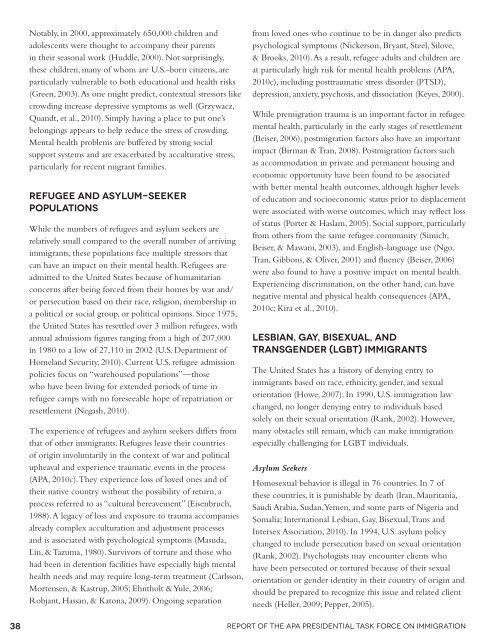Crossroads: The Psychology of Immigration in the New Century
Crossroads: The Psychology of Immigration in the New Century
Crossroads: The Psychology of Immigration in the New Century
Create successful ePaper yourself
Turn your PDF publications into a flip-book with our unique Google optimized e-Paper software.
Notably, <strong>in</strong> 2000, approximately 650,000 children and<br />
adolescents were thought to accompany <strong>the</strong>ir parents<br />
<strong>in</strong> <strong>the</strong>ir seasonal work (Huddle, 2000). Not surpris<strong>in</strong>gly,<br />
<strong>the</strong>se children, many <strong>of</strong> whom are U.S.-born citizens, are<br />
particularly vulnerable to both educational and health risks<br />
(Green, 2003). As one might predict, contextual stressors like<br />
crowd<strong>in</strong>g <strong>in</strong>crease depressive symptoms as well (Grzywacz,<br />
Quandt, et al., 2010). Simply hav<strong>in</strong>g a place to put one’s<br />
belong<strong>in</strong>gs appears to help reduce <strong>the</strong> stress <strong>of</strong> crowd<strong>in</strong>g.<br />
Mental health problems are buffered by strong social<br />
support systems and are exacerbated by acculturative stress,<br />
particularly for recent migrant families.<br />
refugee and asylum-seeker<br />
Populations<br />
While <strong>the</strong> numbers <strong>of</strong> refugees and asylum seekers are<br />
relatively small compared to <strong>the</strong> overall number <strong>of</strong> arriv<strong>in</strong>g<br />
immigrants, <strong>the</strong>se populations face multiple stressors that<br />
can have an impact on <strong>the</strong>ir mental health. Refugees are<br />
admitted to <strong>the</strong> United States because <strong>of</strong> humanitarian<br />
concerns after be<strong>in</strong>g forced from <strong>the</strong>ir homes by war and/<br />
or persecution based on <strong>the</strong>ir race, religion, membership <strong>in</strong><br />
a political or social group, or political op<strong>in</strong>ions. S<strong>in</strong>ce 1975,<br />
<strong>the</strong> United States has resettled over 3 million refugees, with<br />
annual admissions figures rang<strong>in</strong>g from a high <strong>of</strong> 207,000<br />
<strong>in</strong> 1980 to a low <strong>of</strong> 27,110 <strong>in</strong> 2002 (U.S. Department <strong>of</strong><br />
Homeland Security, 2010). Current U.S. refugee admission<br />
policies focus on “warehoused populations”—those<br />
who have been liv<strong>in</strong>g for extended periods <strong>of</strong> time <strong>in</strong><br />
refugee camps with no foreseeable hope <strong>of</strong> repatriation or<br />
resettlement (Negash, 2010).<br />
<strong>The</strong> experience <strong>of</strong> refugees and asylum seekers differs from<br />
that <strong>of</strong> o<strong>the</strong>r immigrants. Refugees leave <strong>the</strong>ir countries<br />
<strong>of</strong> orig<strong>in</strong> <strong>in</strong>voluntarily <strong>in</strong> <strong>the</strong> context <strong>of</strong> war and political<br />
upheaval and experience traumatic events <strong>in</strong> <strong>the</strong> process<br />
(APA, 2010c). <strong>The</strong>y experience loss <strong>of</strong> loved ones and <strong>of</strong><br />
<strong>the</strong>ir native country without <strong>the</strong> possibility <strong>of</strong> return, a<br />
process referred to as “cultural bereavement” (Eisenbruch,<br />
1988). A legacy <strong>of</strong> loss and exposure to trauma accompanies<br />
already complex acculturation and adjustment processes<br />
and is associated with psychological symptoms (Masuda,<br />
L<strong>in</strong>, & Tazuma, 1980). Survivors <strong>of</strong> torture and those who<br />
had been <strong>in</strong> detention facilities have especially high mental<br />
health needs and may require long-term treatment (Carlsson,<br />
Mortensen, & Kastrup, 2005; Ehntholt & Yule, 2006;<br />
Robjant, Hassan, & Katona, 2009). Ongo<strong>in</strong>g separation<br />
from loved ones who cont<strong>in</strong>ue to be <strong>in</strong> danger also predicts<br />
psychological symptoms (Nickerson, Bryant, Steel, Silove,<br />
& Brooks, 2010). As a result, refugee adults and children are<br />
at particularly high risk for mental health problems (APA,<br />
2010c), <strong>in</strong>clud<strong>in</strong>g posttraumatic stress disorder (PTSD),<br />
depression, anxiety, psychosis, and dissociation (Keyes, 2000).<br />
While premigration trauma is an important factor <strong>in</strong> refugee<br />
mental health, particularly <strong>in</strong> <strong>the</strong> early stages <strong>of</strong> resettlement<br />
(Beiser, 2006), postmigration factors also have an important<br />
impact (Birman & Tran, 2008). Postmigration factors such<br />
as accommodation <strong>in</strong> private and permanent hous<strong>in</strong>g and<br />
economic opportunity have been found to be associated<br />
with better mental health outcomes, although higher levels<br />
<strong>of</strong> education and socioeconomic status prior to displacement<br />
were associated with worse outcomes, which may reflect loss<br />
<strong>of</strong> status (Porter & Haslam, 2005). Social support, particularly<br />
from o<strong>the</strong>rs from <strong>the</strong> same refugee community (Simich,<br />
Beiser, & Mawani, 2003), and English-language use (Ngo,<br />
Tran, Gibbons, & Oliver, 2001) and fluency (Beiser, 2006)<br />
were also found to have a positive impact on mental health.<br />
Experienc<strong>in</strong>g discrim<strong>in</strong>ation, on <strong>the</strong> o<strong>the</strong>r hand, can have<br />
negative mental and physical health consequences (APA,<br />
2010c; Kira et al., 2010).<br />
Lesbian, Gay, Bisexual, and<br />
Transgender (LGBT) Immigrants<br />
<strong>The</strong> United States has a history <strong>of</strong> deny<strong>in</strong>g entry to<br />
immigrants based on race, ethnicity, gender, and sexual<br />
orientation (Howe, 2007). In 1990, U.S. immigration law<br />
changed, no longer deny<strong>in</strong>g entry to <strong>in</strong>dividuals based<br />
solely on <strong>the</strong>ir sexual orientation (Rank, 2002). However,<br />
many obstacles still rema<strong>in</strong>, which can make immigration<br />
especially challeng<strong>in</strong>g for LGBT <strong>in</strong>dividuals.<br />
Asylum Seekers<br />
Homosexual behavior is illegal <strong>in</strong> 76 countries. In 7 <strong>of</strong><br />
<strong>the</strong>se countries, it is punishable by death (Iran, Mauritania,<br />
Saudi Arabia, Sudan, Yemen, and some parts <strong>of</strong> Nigeria and<br />
Somalia; International Lesbian, Gay, Bisexual, Trans and<br />
Intersex Association, 2010). In 1994, U.S. asylum policy<br />
changed to <strong>in</strong>clude persecution based on sexual orientation<br />
(Rank, 2002). Psychologists may encounter clients who<br />
have been persecuted or tortured because <strong>of</strong> <strong>the</strong>ir sexual<br />
orientation or gender identity <strong>in</strong> <strong>the</strong>ir country <strong>of</strong> orig<strong>in</strong> and<br />
should be prepared to recognize this issue and related client<br />
needs (Heller, 2009; Pepper, 2005).<br />
38 Report <strong>of</strong> <strong>the</strong> APA Presidential Task Force on <strong>Immigration</strong>
















